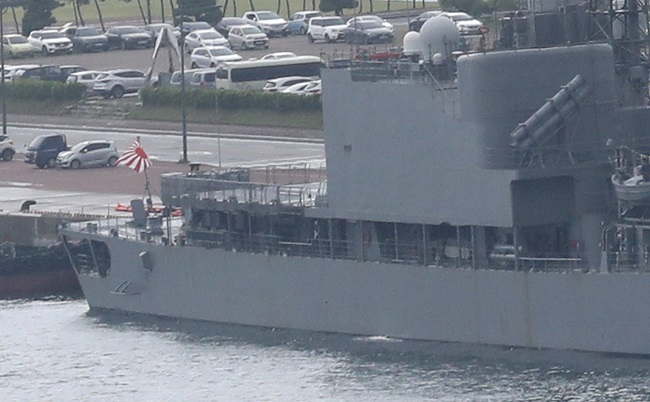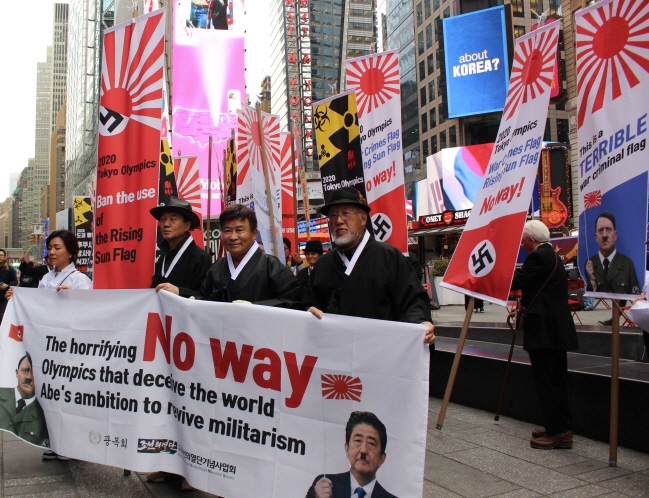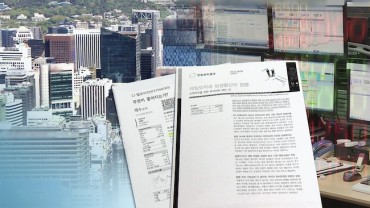
Japan’s JS Hamagiri destroyer hoisting the Rising Sun flag arrives at South Korea’s southeastern port city of Busan on May 29, 2023, to participate in the Eastern Endeavor 23 exercise in the international waters southeast of Jeju Island later in the week. (Yonhap)
SEOUL, May 31 (Korea Bizwire) — A Japanese warship displaying the Japan-Self Defense Forces flag, reminiscent of the Rising Sun Flag, arrived at the Port of Busan on Monday, stirring strong reactions from civic groups who view the flag as a symbol of past wartime aggression.
The contentious matter has spilled into the political arena, with the main opposition Democratic Party continuing its critique of the JS Hamagiri destroyer’s arrival at the Busan Naval Operations Base.
The warship was observed flying a self-defense flag, which bears resemblance to Japan’s imperial-era flag, leading to sharp condemnation of President Yoon Suk Yeol’s foreign policy by the Democratic Party.
During a parliamentary committee meeting, Rep. Yoo Jung-ju emphasized the historical significance, stating, “When Japan invaded the Korean Peninsula, the Japanese flag was flown in Busan, a strategic location for invasion.”
Yoo added, “Despite the evident lack of historical awareness, neither the Yoon administration nor the ruling party seems to acknowledge this issue.”
Rep. Kim Byung-joo, an Army general-turned-lawmaker, echoed these sentiments during a discussion on MBC radio, declaring, “In a situation where Japan does not address historical matters and further asserts claims on Dokdo, it is disrespectful to allow them to display the controversial flag.”
He further questioned, “What kind of country would permit the German Navy to hoist the Nazi flag?”

A member of the far-right National Party of Japan waves the Rising Sun Flag outside the Olympic athletes’ village in Tokyo on July 16, 2021, in protest to a message hung outside South Korean athletes’ rooms that some Japanese accuse of being overly political and anti-Japanese. (Yonhap)
While it is true that the Nazi German employed the Hakenkreuz (swastika) and the Japanese utilized the Rising Sun Flag during World War II, their post-war treatment and international perceptions of the symbols diverged significantly.
Germany unequivocally renounced the use of the Hakenkreuz in the post-war era, recognizing its association with imperial Germany, supremacist ideologies, and war.
Conversely, Japan continued to employ the Rising Sun Flag, viewing it as a symbol of tradition and a military emblem.
This distinction is notable, as Germany, as the aggressor in World War II, has consistently expressed genuine apologies to the nations it victimized, while Japan has taken a contrasting approach.
The international community, in the aftermath of the war, adopted a stringent stance against the Hakenkreuz but showed a relatively more permissive attitude toward the wartime flag of Japan.
Consequently, the symbol has been employed in the United States and Europe with little objection, whereas South Korean netizens have been actively protesting against its usage.

South Korean civic groups hold a rally against the use of Japan’s imperial flag during the Tokyo Olympics in Manhattan, New York City, on Nov. 7, 2019. (Yonhap)
Human reactions to particular imagery are shaped by the associations and experiences tied to those images.
The intensity of the response is often heightened among groups that have undergone specific traumas connected to the emblem in question.
Almost universally, people react negatively to former Nazi symbols such as the Hakenkreuz and the term “Nazi” due to the harrowing images of war crimes they evoke.
However, it is improbable that Koreans would immediately associate the Nazi flag with appalling acts of military sexual slavery, torture, and murder.
For them to recall the horrors of war, they would need to contemplate other flags alongside it.
Jerry M. Kim (jerry_kim@koreabizwire.com)






